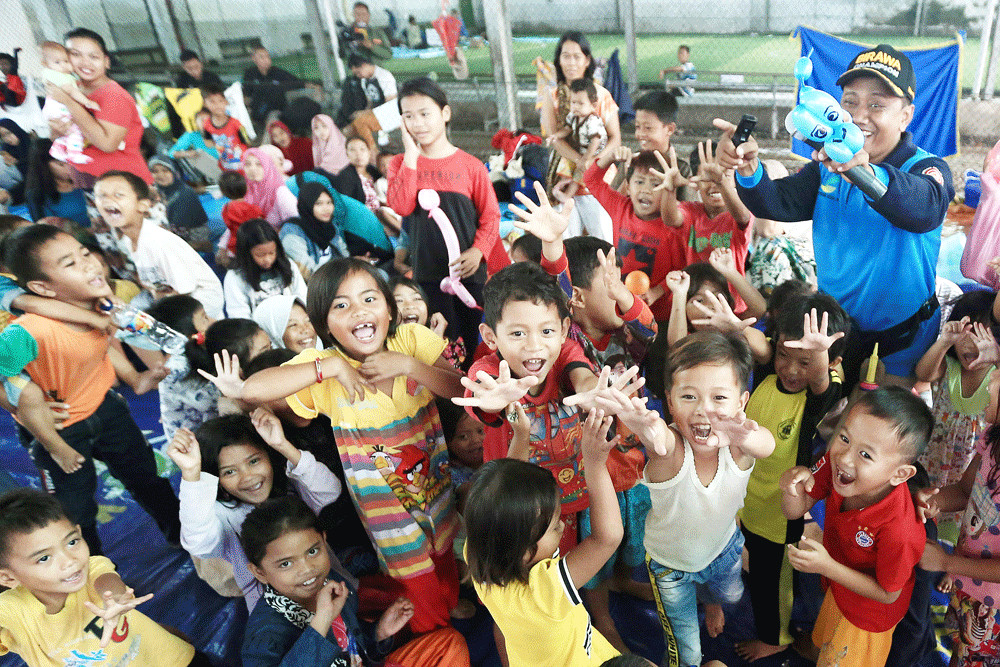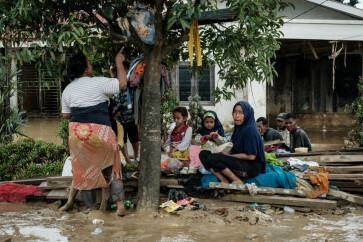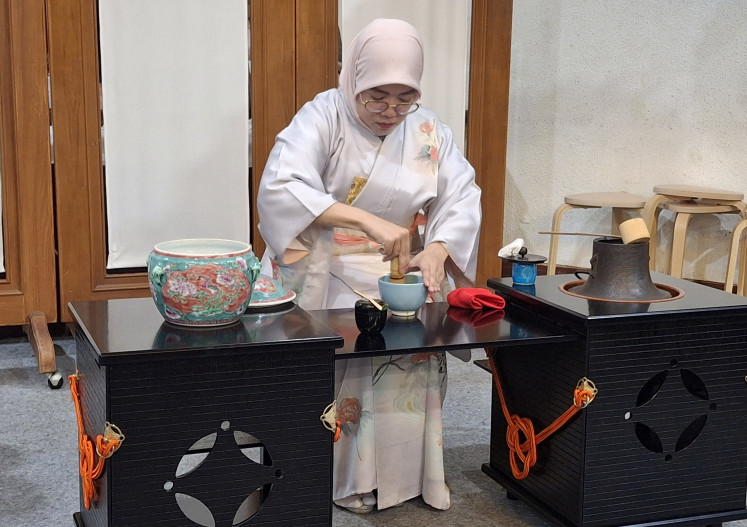Popular Reads
Top Results
Can't find what you're looking for?
View all search resultsPopular Reads
Top Results
Can't find what you're looking for?
View all search resultsDisastrous year in Indonesia calls upon resilience for 2019
It is crucial to know that change is accessible and can be advocated for at multiple levels. While it is the government that must right its wrongs, both individuals and communities can do their part.
Change text size
Gift Premium Articles
to Anyone
The tsunami that took the lives of over 400 people in the Sunda Strait is just one of 2,426 natural disasters in Indonesia in 2018.
The National Disaster Mitigation Agency (BNPB) has declared 4,231 people dead or missing as a result of natural disasters, making 2018 the most tumultuous year Indonesia has faced since 2007.
The 7.4-magnitude earthquake in Palu, Central Sulawesi in September and the eruptions of Anak Krakatau are some of the most notorious examples of the earthquakes, tsunamis and volcanic eruptions Indonesia fell victim to this year. Willem Rampangilei of the BNPB stated that despite the fact that geological hazards accounted for only 3 percent of natural disasters in 2018, they claimed the most lives. Inflicting over 4,000 people, these casualties are sobering reminders of the importance of disaster risk reduction and preparation.
While the BNPB was founded with the intention of legislating on key risk reduction policies and allocating a budget to improve research and early warning tools, the events of 2018 prove that it is falling short. In a series of tweets, BNPB spokesman Sutopo Purwo Nugroho revealed that the tsunami early warning system had not been working since 2012 due to vandalism. According to AP, while decentralization of risk-reduction is shared among local governments, their negligence left the buoys unrepaired. Video surveillance also shows that victims of tsunamis did not seek higher ground -- an immediate response to such calamities -- proving that people were not informed on what to do in such emergencies.
The result speaks for itself: hundreds of victims losing their lives without a warning when a siren could have been in place, or education could have been instilled. Moreover, the collapse of infrastructure and homes not only have plummeting economic costs, they are a testament of the government’s failure to sufficiently mitigate risks by enforcing stricter construction laws to build stronger structures.
Located in the Ring of Fire, Indonesia is prone to natural disasters. Entering 2019, the resolve to become more disaster-resilient should be stronger than ever; such circumstances should motivate preparedness, not prolong neglect. As a signatory of the Sendai Framework -- the world’s first voluntary agreement on disaster risk reduction after the 2015 Agenda -- and the UN Sustainable Development Goals (SDGs), Indonesia needs to strengthen its commitment not only to the international community but to its people.
In a paper written by the United Nations Office for Disaster Risk Reduction (UNISDR), the link between disaster risk reduction and development is symbiotic. Indonesia’s turmoil this year is a paradigm case study, highlighting SDGs 4, 9 and 11. Improved infrastructure that can “anticipate, absorb, adapt to and or rapidly recover” from hazards (Target 9.1)and enforcing stricter regulations to ensure sustainable, resilient urban development (Target 11.3, 11.5, 11.B, 11.C)are the backbone to durable communities. Developing advanced technology and infrastructure against natural disasters demands a budget that Indonesia struggles to meet, but there are simple techniques builders can adopt which can build stronger foundations, making structures less vulnerable to instant collapse.
Japan is a leading example of disaster-risk reduction and readiness. One of their key missions includes raising awareness on natural disasters to educate people to better protect their lives (Target 4.7). As the focal point, schools implement courses which educates people on disaster causes, consequences and how to prepare for and respond to the impacts of hazards. By making this information readily available and easy to understand, communication becomes smoother, and individuals increase their chances of survival.
Read also: [UPDATED] Sunda Strait tsunami: What we know so far
It is crucial to know that change is accessible and can be advocated for at multiple levels. While it is the government who must right its wrongs, both individuals and communities can do their part.
A symposium conducted by the United Nations University Institute for Sustainability and Peace (UNU-ISP) emphasized the importance of psychological support for victims of disasters and their loved ones by the community. Counseling those with post-traumatic stress disorder (PTSD) or including victims in the rebuilding process are two examples of “motivating the community” and assisting the coping process of those affected.
Monetary donations are a tried and tested approach to best support disaster relief. Organizations providing immediate aid and resources are essential for smoother recovery, but several non-profits are specifically committed to education and infrastructure, placing the question of long-term recovery on the spotlight.
Here are some organizations working in disaster mitigation and relief:
- Mercy Corps Indonesia is working to provide medical assistance to victims of hazards, specifically in hard-to-reach areas. While the community has an important role in locating and retrieving victims trapped under collapsed structures, medical expertise and proper tools are necessary, invaluable assets to treat those affected. Send your donations here.
- Red Cross Indonesia (PMI) actively works on disaster reports and provides medical assistance in affected areas, particularly where infrastructure is weak or damaged. Their disaster report for instance, in the Sunda Strait, is being updated on a daily basis on their twitter feed. PMI has various donation campaigns which you can contribute to here.
- Aksi Cepat Tanggap (ACT) provides humanitarian assistance in situations which demand emergency response. In addition, ACT also gives victims a voice by reporting the catastrophes endured by survivors. Focusing on humanitarian aid and development, ACT is involved in missions ranging in a variety of issues, both national and global. To find out how you can help, visit their page here.
- Wahana Visi Indonesia (WHI), World Vision’s local partner, has deployed an emergency response team to the Sunda Strait to assess the damages of the tsunami. Margarettha Siregar, HEA Director of Wahana Visi Indonesia,states the team will “establish the kind of support that is needed including determining if the government and emergency responders have the capacity to handle operations without additional requested support.” In 2017-2018, WHI has worked in 14 provinces in 60 service areas across Indonesia, focusing on emergency situations, basic needs, and child welfare. If you have emergency response experience, apply to be a part of the emergency response team here, or visit their page to make a donation.
- Yayasan Plan International Indonesia, as part of the wider Plan International organization, is a humanitarian organization focusing on children’s rights and gender equality. In face of natural disasters, the organization sends emergency response teams (ERTs) to evaluate disaster zones and supports those inflicted through non-food supplies such as temporary shelters, school supplies, and cleaning tools. By acting as a channel for such supplies, your donations are guaranteed to reach victims of disasters; contribute your donations here.
- Build Change has been working in Indonesia since 2005 with a focus on building earthquake resistant structures. The organization focuses on rectifying the long-term consequences of natural disasters through reconstruction and transferring skills. As part of the “Build Better Materials” project, local brickmakers, for instance, are supported by working together to produce higher quality materials through improved techniques. In collaboration with technical experts, these improved techniques have redesigned homes and schools in earthquake-inflicted zones in their “Build Back Better” projects.
During these turbulent times, it is more vital than ever that we stand in solidarity. The spark of a new year is a reflective period for us all, it is up to the collective efforts of individuals at all levels to advance a more resilient Indonesia in 2019. (kes)
***
Paxia Ksatryo is an undergraduate student pursuing a degree in European-Asian affairs and law at Sciences Po Paris. Her experience in a UN think tank and a start-up PR agency encapsulates her desire to reach the masses. In her spare time she enjoys brunching, debating and reading architecture magazines. She can be reached on Instagram as @paxionfruit and LinkedIn.











